Reflective Essay on Patient Experience and Nursing Care (NUR1201)
VerifiedAdded on 2023/06/03
|8
|2294
|320
Essay
AI Summary
This reflective essay examines a 75-year-old patient's experience in a healthcare setting, using the Gibbs reflection cycle to analyze the care received. The essay details the patient's account of a negative experience in the emergency department, highlighting issues such as prolonged wait times, inadequate pain management, and a lack of patient-centered care. The author reflects on their own values and beliefs regarding patient care, emphasizing the importance of respecting patient preferences, providing comfort, and ensuring effective communication. The analysis section identifies violations of patient-centered care principles and explores the impact of these shortcomings on the patient's experience. The essay concludes with an action plan for improving soft skills and professional competence, and it underscores the need for reforms in healthcare to prioritize patient needs and enhance the overall care experience. The essay references relevant literature and emphasizes the importance of therapeutic relationships, effective communication, and prioritizing patient interests.
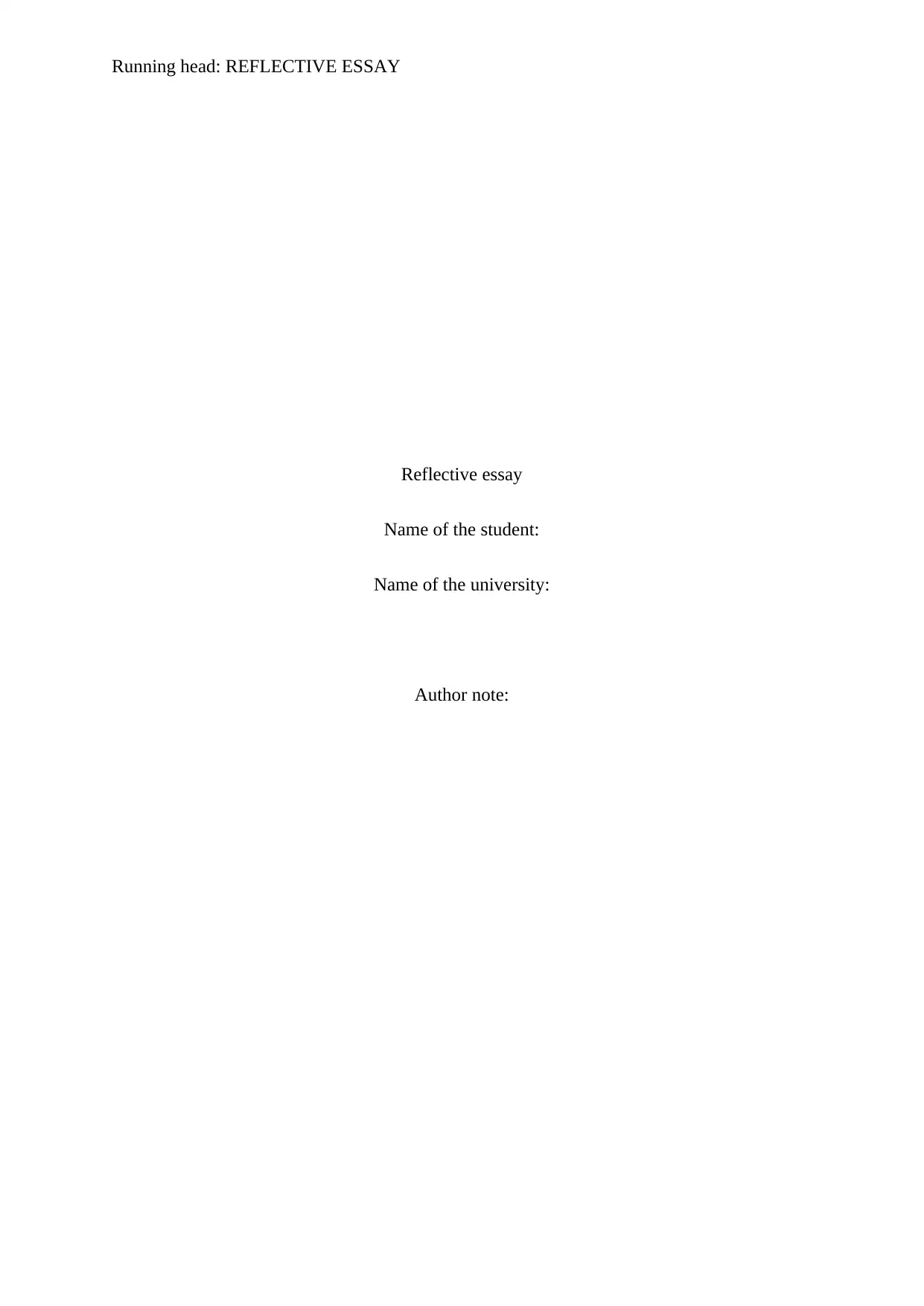
Running head: REFLECTIVE ESSAY
Reflective essay
Name of the student:
Name of the university:
Author note:
Reflective essay
Name of the student:
Name of the university:
Author note:
Paraphrase This Document
Need a fresh take? Get an instant paraphrase of this document with our AI Paraphraser
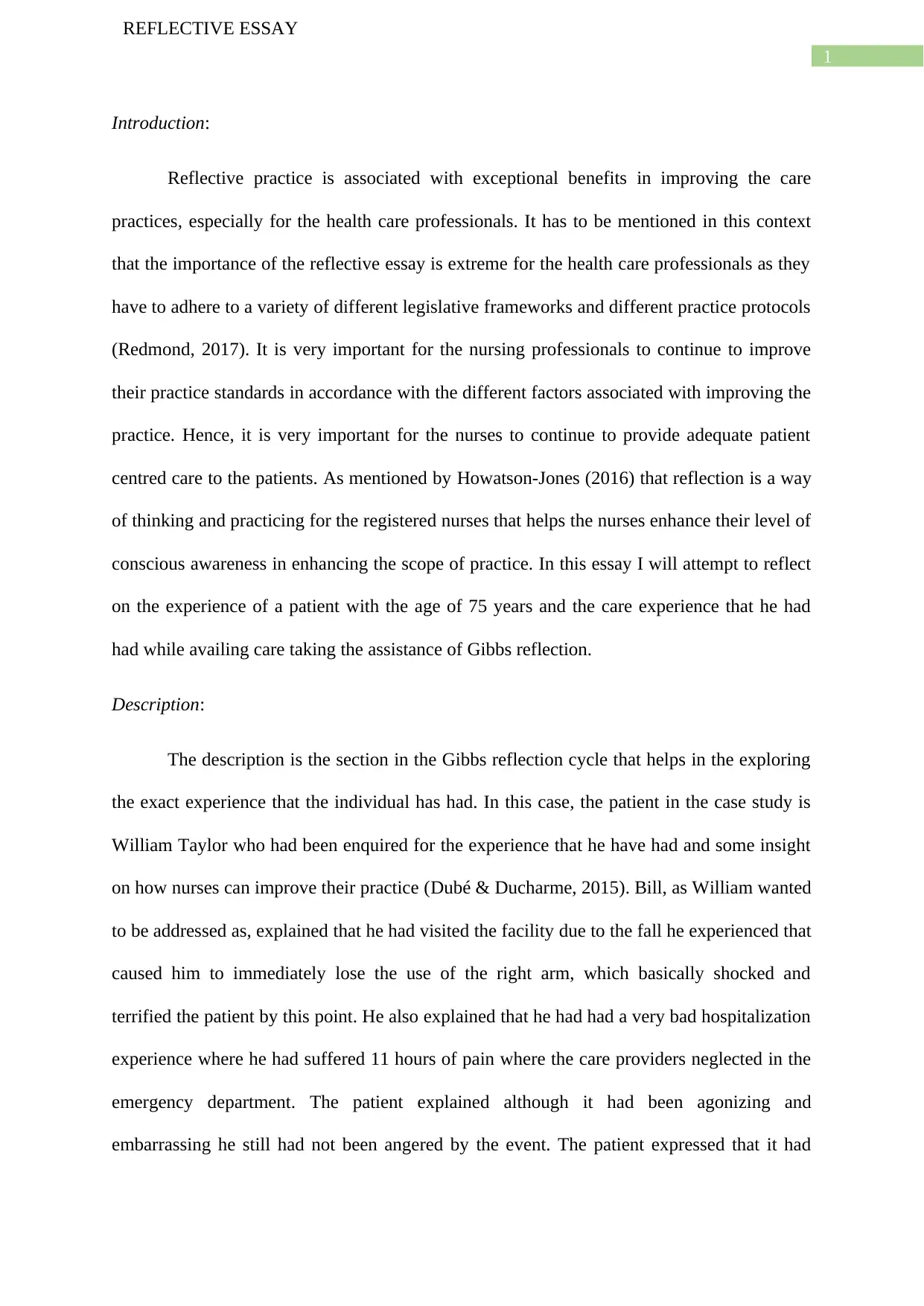
1
REFLECTIVE ESSAY
Introduction:
Reflective practice is associated with exceptional benefits in improving the care
practices, especially for the health care professionals. It has to be mentioned in this context
that the importance of the reflective essay is extreme for the health care professionals as they
have to adhere to a variety of different legislative frameworks and different practice protocols
(Redmond, 2017). It is very important for the nursing professionals to continue to improve
their practice standards in accordance with the different factors associated with improving the
practice. Hence, it is very important for the nurses to continue to provide adequate patient
centred care to the patients. As mentioned by Howatson-Jones (2016) that reflection is a way
of thinking and practicing for the registered nurses that helps the nurses enhance their level of
conscious awareness in enhancing the scope of practice. In this essay I will attempt to reflect
on the experience of a patient with the age of 75 years and the care experience that he had
had while availing care taking the assistance of Gibbs reflection.
Description:
The description is the section in the Gibbs reflection cycle that helps in the exploring
the exact experience that the individual has had. In this case, the patient in the case study is
William Taylor who had been enquired for the experience that he have had and some insight
on how nurses can improve their practice (Dubé & Ducharme, 2015). Bill, as William wanted
to be addressed as, explained that he had visited the facility due to the fall he experienced that
caused him to immediately lose the use of the right arm, which basically shocked and
terrified the patient by this point. He also explained that he had had a very bad hospitalization
experience where he had suffered 11 hours of pain where the care providers neglected in the
emergency department. The patient explained although it had been agonizing and
embarrassing he still had not been angered by the event. The patient expressed that it had
REFLECTIVE ESSAY
Introduction:
Reflective practice is associated with exceptional benefits in improving the care
practices, especially for the health care professionals. It has to be mentioned in this context
that the importance of the reflective essay is extreme for the health care professionals as they
have to adhere to a variety of different legislative frameworks and different practice protocols
(Redmond, 2017). It is very important for the nursing professionals to continue to improve
their practice standards in accordance with the different factors associated with improving the
practice. Hence, it is very important for the nurses to continue to provide adequate patient
centred care to the patients. As mentioned by Howatson-Jones (2016) that reflection is a way
of thinking and practicing for the registered nurses that helps the nurses enhance their level of
conscious awareness in enhancing the scope of practice. In this essay I will attempt to reflect
on the experience of a patient with the age of 75 years and the care experience that he had
had while availing care taking the assistance of Gibbs reflection.
Description:
The description is the section in the Gibbs reflection cycle that helps in the exploring
the exact experience that the individual has had. In this case, the patient in the case study is
William Taylor who had been enquired for the experience that he have had and some insight
on how nurses can improve their practice (Dubé & Ducharme, 2015). Bill, as William wanted
to be addressed as, explained that he had visited the facility due to the fall he experienced that
caused him to immediately lose the use of the right arm, which basically shocked and
terrified the patient by this point. He also explained that he had had a very bad hospitalization
experience where he had suffered 11 hours of pain where the care providers neglected in the
emergency department. The patient explained although it had been agonizing and
embarrassing he still had not been angered by the event. The patient expressed that it had
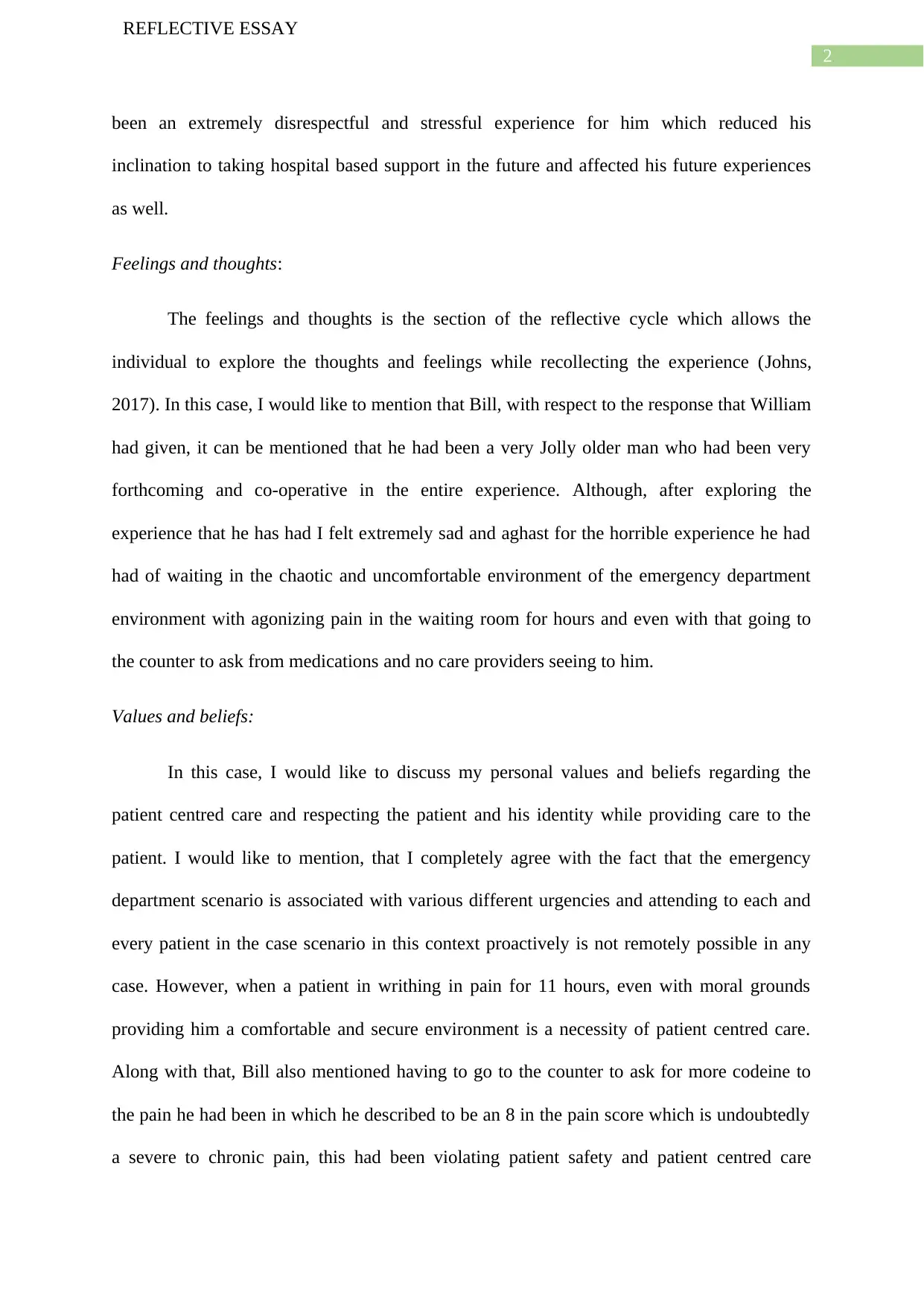
2
REFLECTIVE ESSAY
been an extremely disrespectful and stressful experience for him which reduced his
inclination to taking hospital based support in the future and affected his future experiences
as well.
Feelings and thoughts:
The feelings and thoughts is the section of the reflective cycle which allows the
individual to explore the thoughts and feelings while recollecting the experience (Johns,
2017). In this case, I would like to mention that Bill, with respect to the response that William
had given, it can be mentioned that he had been a very Jolly older man who had been very
forthcoming and co-operative in the entire experience. Although, after exploring the
experience that he has had I felt extremely sad and aghast for the horrible experience he had
had of waiting in the chaotic and uncomfortable environment of the emergency department
environment with agonizing pain in the waiting room for hours and even with that going to
the counter to ask from medications and no care providers seeing to him.
Values and beliefs:
In this case, I would like to discuss my personal values and beliefs regarding the
patient centred care and respecting the patient and his identity while providing care to the
patient. I would like to mention, that I completely agree with the fact that the emergency
department scenario is associated with various different urgencies and attending to each and
every patient in the case scenario in this context proactively is not remotely possible in any
case. However, when a patient in writhing in pain for 11 hours, even with moral grounds
providing him a comfortable and secure environment is a necessity of patient centred care.
Along with that, Bill also mentioned having to go to the counter to ask for more codeine to
the pain he had been in which he described to be an 8 in the pain score which is undoubtedly
a severe to chronic pain, this had been violating patient safety and patient centred care
REFLECTIVE ESSAY
been an extremely disrespectful and stressful experience for him which reduced his
inclination to taking hospital based support in the future and affected his future experiences
as well.
Feelings and thoughts:
The feelings and thoughts is the section of the reflective cycle which allows the
individual to explore the thoughts and feelings while recollecting the experience (Johns,
2017). In this case, I would like to mention that Bill, with respect to the response that William
had given, it can be mentioned that he had been a very Jolly older man who had been very
forthcoming and co-operative in the entire experience. Although, after exploring the
experience that he has had I felt extremely sad and aghast for the horrible experience he had
had of waiting in the chaotic and uncomfortable environment of the emergency department
environment with agonizing pain in the waiting room for hours and even with that going to
the counter to ask from medications and no care providers seeing to him.
Values and beliefs:
In this case, I would like to discuss my personal values and beliefs regarding the
patient centred care and respecting the patient and his identity while providing care to the
patient. I would like to mention, that I completely agree with the fact that the emergency
department scenario is associated with various different urgencies and attending to each and
every patient in the case scenario in this context proactively is not remotely possible in any
case. However, when a patient in writhing in pain for 11 hours, even with moral grounds
providing him a comfortable and secure environment is a necessity of patient centred care.
Along with that, Bill also mentioned having to go to the counter to ask for more codeine to
the pain he had been in which he described to be an 8 in the pain score which is undoubtedly
a severe to chronic pain, this had been violating patient safety and patient centred care
⊘ This is a preview!⊘
Do you want full access?
Subscribe today to unlock all pages.

Trusted by 1+ million students worldwide
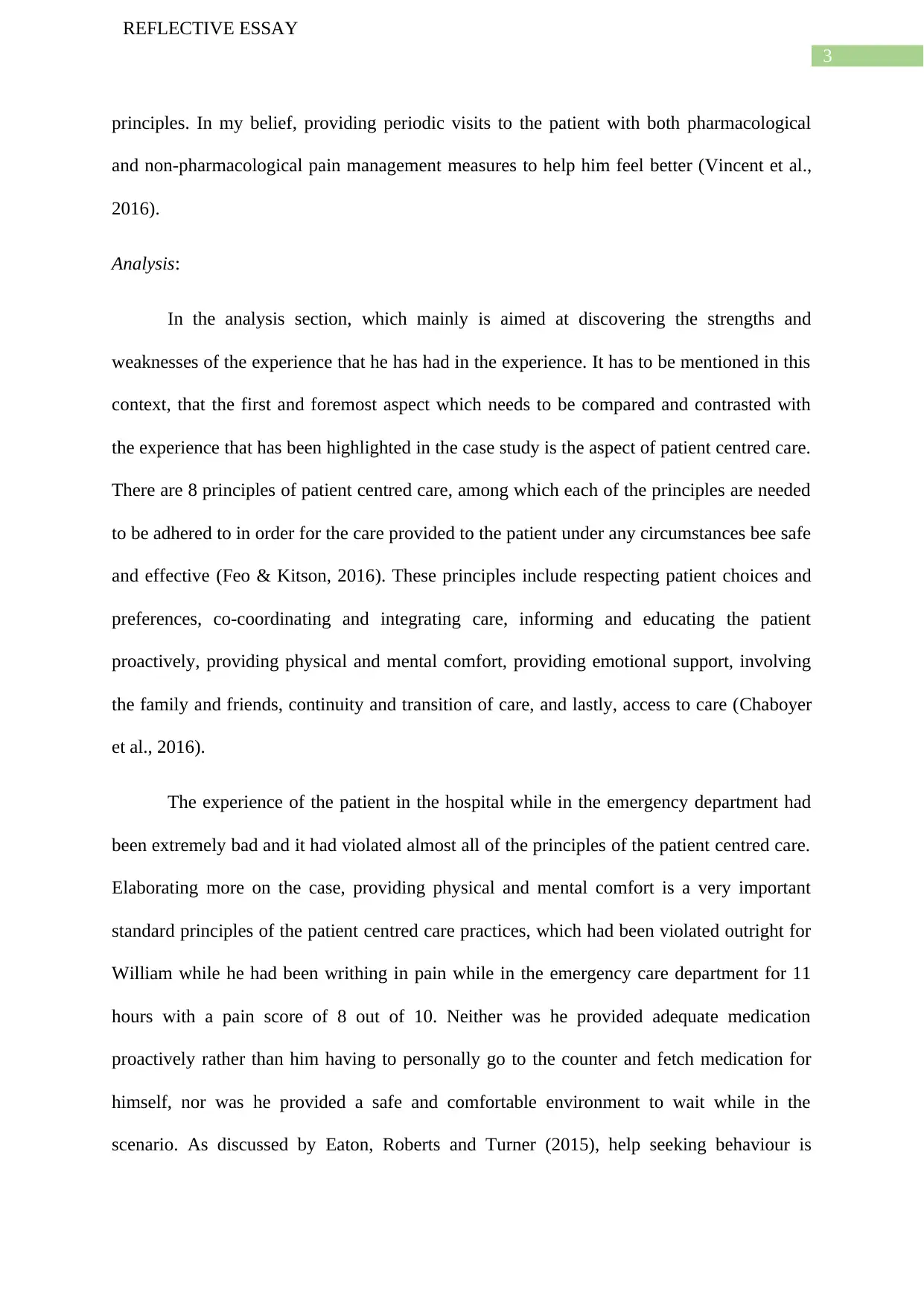
3
REFLECTIVE ESSAY
principles. In my belief, providing periodic visits to the patient with both pharmacological
and non-pharmacological pain management measures to help him feel better (Vincent et al.,
2016).
Analysis:
In the analysis section, which mainly is aimed at discovering the strengths and
weaknesses of the experience that he has had in the experience. It has to be mentioned in this
context, that the first and foremost aspect which needs to be compared and contrasted with
the experience that has been highlighted in the case study is the aspect of patient centred care.
There are 8 principles of patient centred care, among which each of the principles are needed
to be adhered to in order for the care provided to the patient under any circumstances bee safe
and effective (Feo & Kitson, 2016). These principles include respecting patient choices and
preferences, co-coordinating and integrating care, informing and educating the patient
proactively, providing physical and mental comfort, providing emotional support, involving
the family and friends, continuity and transition of care, and lastly, access to care (Chaboyer
et al., 2016).
The experience of the patient in the hospital while in the emergency department had
been extremely bad and it had violated almost all of the principles of the patient centred care.
Elaborating more on the case, providing physical and mental comfort is a very important
standard principles of the patient centred care practices, which had been violated outright for
William while he had been writhing in pain while in the emergency care department for 11
hours with a pain score of 8 out of 10. Neither was he provided adequate medication
proactively rather than him having to personally go to the counter and fetch medication for
himself, nor was he provided a safe and comfortable environment to wait while in the
scenario. As discussed by Eaton, Roberts and Turner (2015), help seeking behaviour is
REFLECTIVE ESSAY
principles. In my belief, providing periodic visits to the patient with both pharmacological
and non-pharmacological pain management measures to help him feel better (Vincent et al.,
2016).
Analysis:
In the analysis section, which mainly is aimed at discovering the strengths and
weaknesses of the experience that he has had in the experience. It has to be mentioned in this
context, that the first and foremost aspect which needs to be compared and contrasted with
the experience that has been highlighted in the case study is the aspect of patient centred care.
There are 8 principles of patient centred care, among which each of the principles are needed
to be adhered to in order for the care provided to the patient under any circumstances bee safe
and effective (Feo & Kitson, 2016). These principles include respecting patient choices and
preferences, co-coordinating and integrating care, informing and educating the patient
proactively, providing physical and mental comfort, providing emotional support, involving
the family and friends, continuity and transition of care, and lastly, access to care (Chaboyer
et al., 2016).
The experience of the patient in the hospital while in the emergency department had
been extremely bad and it had violated almost all of the principles of the patient centred care.
Elaborating more on the case, providing physical and mental comfort is a very important
standard principles of the patient centred care practices, which had been violated outright for
William while he had been writhing in pain while in the emergency care department for 11
hours with a pain score of 8 out of 10. Neither was he provided adequate medication
proactively rather than him having to personally go to the counter and fetch medication for
himself, nor was he provided a safe and comfortable environment to wait while in the
scenario. As discussed by Eaton, Roberts and Turner (2015), help seeking behaviour is
Paraphrase This Document
Need a fresh take? Get an instant paraphrase of this document with our AI Paraphraser
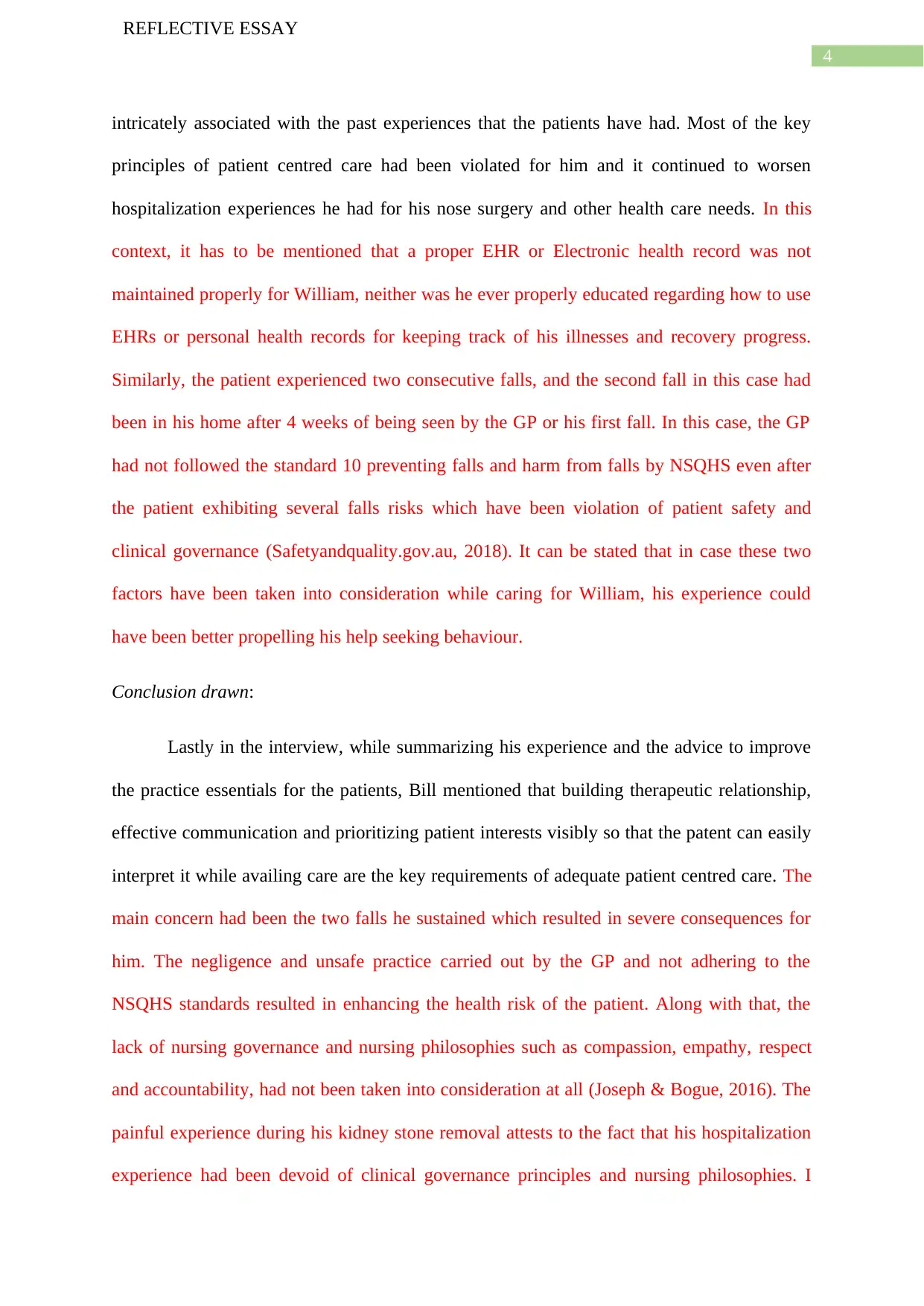
4
REFLECTIVE ESSAY
intricately associated with the past experiences that the patients have had. Most of the key
principles of patient centred care had been violated for him and it continued to worsen
hospitalization experiences he had for his nose surgery and other health care needs. In this
context, it has to be mentioned that a proper EHR or Electronic health record was not
maintained properly for William, neither was he ever properly educated regarding how to use
EHRs or personal health records for keeping track of his illnesses and recovery progress.
Similarly, the patient experienced two consecutive falls, and the second fall in this case had
been in his home after 4 weeks of being seen by the GP or his first fall. In this case, the GP
had not followed the standard 10 preventing falls and harm from falls by NSQHS even after
the patient exhibiting several falls risks which have been violation of patient safety and
clinical governance (Safetyandquality.gov.au, 2018). It can be stated that in case these two
factors have been taken into consideration while caring for William, his experience could
have been better propelling his help seeking behaviour.
Conclusion drawn:
Lastly in the interview, while summarizing his experience and the advice to improve
the practice essentials for the patients, Bill mentioned that building therapeutic relationship,
effective communication and prioritizing patient interests visibly so that the patent can easily
interpret it while availing care are the key requirements of adequate patient centred care. The
main concern had been the two falls he sustained which resulted in severe consequences for
him. The negligence and unsafe practice carried out by the GP and not adhering to the
NSQHS standards resulted in enhancing the health risk of the patient. Along with that, the
lack of nursing governance and nursing philosophies such as compassion, empathy, respect
and accountability, had not been taken into consideration at all (Joseph & Bogue, 2016). The
painful experience during his kidney stone removal attests to the fact that his hospitalization
experience had been devoid of clinical governance principles and nursing philosophies. I
REFLECTIVE ESSAY
intricately associated with the past experiences that the patients have had. Most of the key
principles of patient centred care had been violated for him and it continued to worsen
hospitalization experiences he had for his nose surgery and other health care needs. In this
context, it has to be mentioned that a proper EHR or Electronic health record was not
maintained properly for William, neither was he ever properly educated regarding how to use
EHRs or personal health records for keeping track of his illnesses and recovery progress.
Similarly, the patient experienced two consecutive falls, and the second fall in this case had
been in his home after 4 weeks of being seen by the GP or his first fall. In this case, the GP
had not followed the standard 10 preventing falls and harm from falls by NSQHS even after
the patient exhibiting several falls risks which have been violation of patient safety and
clinical governance (Safetyandquality.gov.au, 2018). It can be stated that in case these two
factors have been taken into consideration while caring for William, his experience could
have been better propelling his help seeking behaviour.
Conclusion drawn:
Lastly in the interview, while summarizing his experience and the advice to improve
the practice essentials for the patients, Bill mentioned that building therapeutic relationship,
effective communication and prioritizing patient interests visibly so that the patent can easily
interpret it while availing care are the key requirements of adequate patient centred care. The
main concern had been the two falls he sustained which resulted in severe consequences for
him. The negligence and unsafe practice carried out by the GP and not adhering to the
NSQHS standards resulted in enhancing the health risk of the patient. Along with that, the
lack of nursing governance and nursing philosophies such as compassion, empathy, respect
and accountability, had not been taken into consideration at all (Joseph & Bogue, 2016). The
painful experience during his kidney stone removal attests to the fact that his hospitalization
experience had been devoid of clinical governance principles and nursing philosophies. I
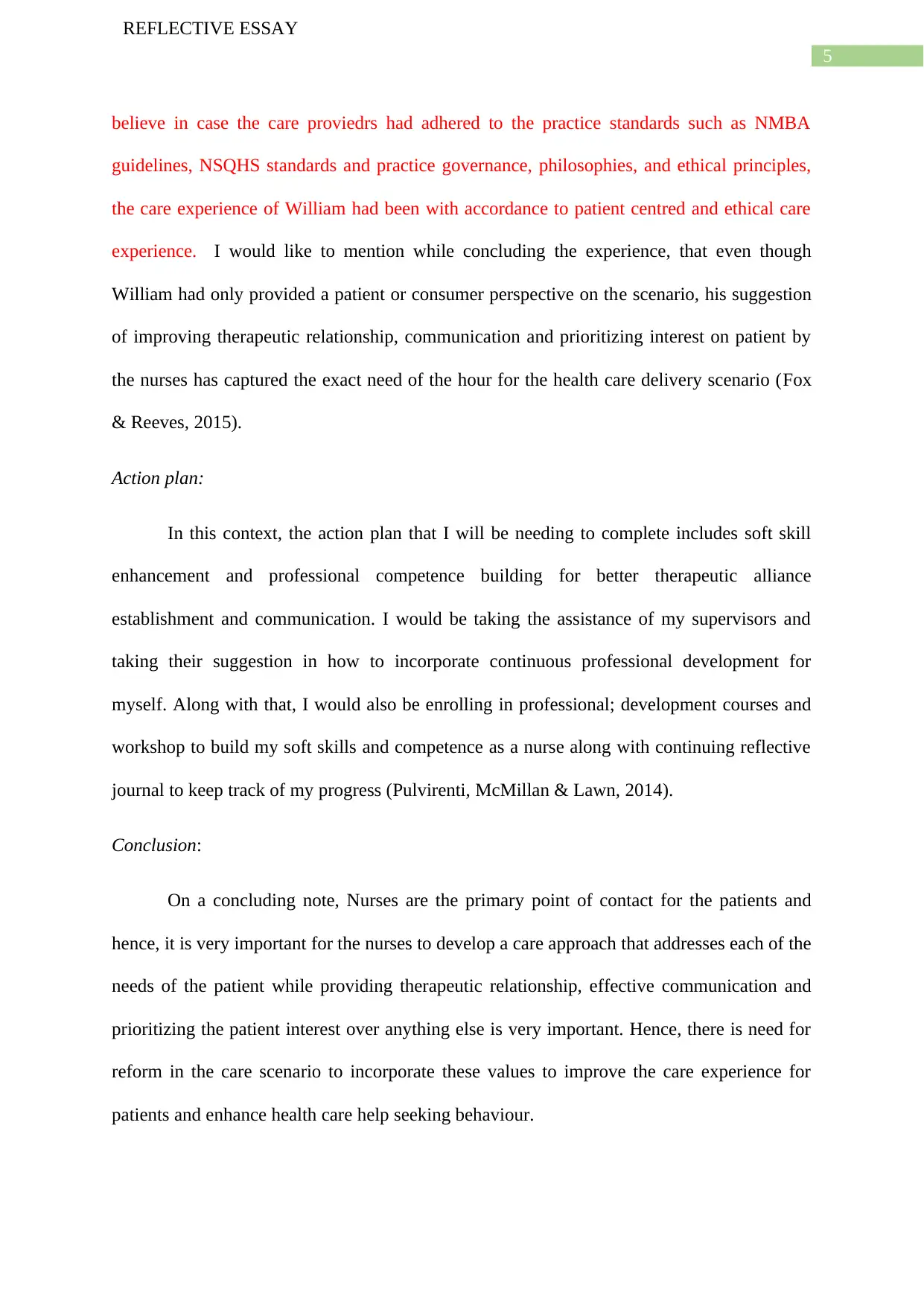
5
REFLECTIVE ESSAY
believe in case the care proviedrs had adhered to the practice standards such as NMBA
guidelines, NSQHS standards and practice governance, philosophies, and ethical principles,
the care experience of William had been with accordance to patient centred and ethical care
experience. I would like to mention while concluding the experience, that even though
William had only provided a patient or consumer perspective on the scenario, his suggestion
of improving therapeutic relationship, communication and prioritizing interest on patient by
the nurses has captured the exact need of the hour for the health care delivery scenario (Fox
& Reeves, 2015).
Action plan:
In this context, the action plan that I will be needing to complete includes soft skill
enhancement and professional competence building for better therapeutic alliance
establishment and communication. I would be taking the assistance of my supervisors and
taking their suggestion in how to incorporate continuous professional development for
myself. Along with that, I would also be enrolling in professional; development courses and
workshop to build my soft skills and competence as a nurse along with continuing reflective
journal to keep track of my progress (Pulvirenti, McMillan & Lawn, 2014).
Conclusion:
On a concluding note, Nurses are the primary point of contact for the patients and
hence, it is very important for the nurses to develop a care approach that addresses each of the
needs of the patient while providing therapeutic relationship, effective communication and
prioritizing the patient interest over anything else is very important. Hence, there is need for
reform in the care scenario to incorporate these values to improve the care experience for
patients and enhance health care help seeking behaviour.
REFLECTIVE ESSAY
believe in case the care proviedrs had adhered to the practice standards such as NMBA
guidelines, NSQHS standards and practice governance, philosophies, and ethical principles,
the care experience of William had been with accordance to patient centred and ethical care
experience. I would like to mention while concluding the experience, that even though
William had only provided a patient or consumer perspective on the scenario, his suggestion
of improving therapeutic relationship, communication and prioritizing interest on patient by
the nurses has captured the exact need of the hour for the health care delivery scenario (Fox
& Reeves, 2015).
Action plan:
In this context, the action plan that I will be needing to complete includes soft skill
enhancement and professional competence building for better therapeutic alliance
establishment and communication. I would be taking the assistance of my supervisors and
taking their suggestion in how to incorporate continuous professional development for
myself. Along with that, I would also be enrolling in professional; development courses and
workshop to build my soft skills and competence as a nurse along with continuing reflective
journal to keep track of my progress (Pulvirenti, McMillan & Lawn, 2014).
Conclusion:
On a concluding note, Nurses are the primary point of contact for the patients and
hence, it is very important for the nurses to develop a care approach that addresses each of the
needs of the patient while providing therapeutic relationship, effective communication and
prioritizing the patient interest over anything else is very important. Hence, there is need for
reform in the care scenario to incorporate these values to improve the care experience for
patients and enhance health care help seeking behaviour.
⊘ This is a preview!⊘
Do you want full access?
Subscribe today to unlock all pages.

Trusted by 1+ million students worldwide
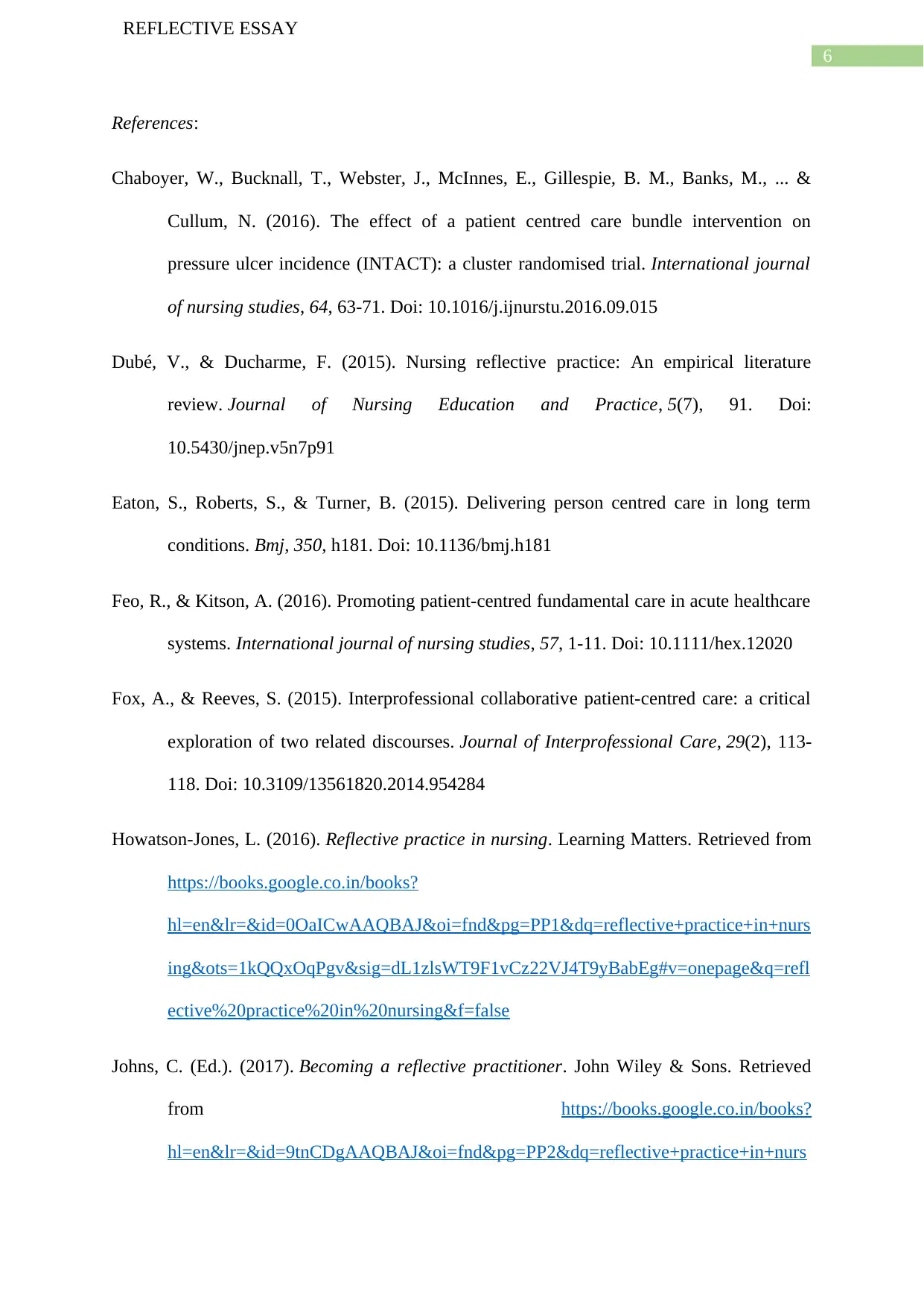
6
REFLECTIVE ESSAY
References:
Chaboyer, W., Bucknall, T., Webster, J., McInnes, E., Gillespie, B. M., Banks, M., ... &
Cullum, N. (2016). The effect of a patient centred care bundle intervention on
pressure ulcer incidence (INTACT): a cluster randomised trial. International journal
of nursing studies, 64, 63-71. Doi: 10.1016/j.ijnurstu.2016.09.015
Dubé, V., & Ducharme, F. (2015). Nursing reflective practice: An empirical literature
review. Journal of Nursing Education and Practice, 5(7), 91. Doi:
10.5430/jnep.v5n7p91
Eaton, S., Roberts, S., & Turner, B. (2015). Delivering person centred care in long term
conditions. Bmj, 350, h181. Doi: 10.1136/bmj.h181
Feo, R., & Kitson, A. (2016). Promoting patient-centred fundamental care in acute healthcare
systems. International journal of nursing studies, 57, 1-11. Doi: 10.1111/hex.12020
Fox, A., & Reeves, S. (2015). Interprofessional collaborative patient-centred care: a critical
exploration of two related discourses. Journal of Interprofessional Care, 29(2), 113-
118. Doi: 10.3109/13561820.2014.954284
Howatson-Jones, L. (2016). Reflective practice in nursing. Learning Matters. Retrieved from
https://books.google.co.in/books?
hl=en&lr=&id=0OaICwAAQBAJ&oi=fnd&pg=PP1&dq=reflective+practice+in+nurs
ing&ots=1kQQxOqPgv&sig=dL1zlsWT9F1vCz22VJ4T9yBabEg#v=onepage&q=refl
ective%20practice%20in%20nursing&f=false
Johns, C. (Ed.). (2017). Becoming a reflective practitioner. John Wiley & Sons. Retrieved
from https://books.google.co.in/books?
hl=en&lr=&id=9tnCDgAAQBAJ&oi=fnd&pg=PP2&dq=reflective+practice+in+nurs
REFLECTIVE ESSAY
References:
Chaboyer, W., Bucknall, T., Webster, J., McInnes, E., Gillespie, B. M., Banks, M., ... &
Cullum, N. (2016). The effect of a patient centred care bundle intervention on
pressure ulcer incidence (INTACT): a cluster randomised trial. International journal
of nursing studies, 64, 63-71. Doi: 10.1016/j.ijnurstu.2016.09.015
Dubé, V., & Ducharme, F. (2015). Nursing reflective practice: An empirical literature
review. Journal of Nursing Education and Practice, 5(7), 91. Doi:
10.5430/jnep.v5n7p91
Eaton, S., Roberts, S., & Turner, B. (2015). Delivering person centred care in long term
conditions. Bmj, 350, h181. Doi: 10.1136/bmj.h181
Feo, R., & Kitson, A. (2016). Promoting patient-centred fundamental care in acute healthcare
systems. International journal of nursing studies, 57, 1-11. Doi: 10.1111/hex.12020
Fox, A., & Reeves, S. (2015). Interprofessional collaborative patient-centred care: a critical
exploration of two related discourses. Journal of Interprofessional Care, 29(2), 113-
118. Doi: 10.3109/13561820.2014.954284
Howatson-Jones, L. (2016). Reflective practice in nursing. Learning Matters. Retrieved from
https://books.google.co.in/books?
hl=en&lr=&id=0OaICwAAQBAJ&oi=fnd&pg=PP1&dq=reflective+practice+in+nurs
ing&ots=1kQQxOqPgv&sig=dL1zlsWT9F1vCz22VJ4T9yBabEg#v=onepage&q=refl
ective%20practice%20in%20nursing&f=false
Johns, C. (Ed.). (2017). Becoming a reflective practitioner. John Wiley & Sons. Retrieved
from https://books.google.co.in/books?
hl=en&lr=&id=9tnCDgAAQBAJ&oi=fnd&pg=PP2&dq=reflective+practice+in+nurs
Paraphrase This Document
Need a fresh take? Get an instant paraphrase of this document with our AI Paraphraser
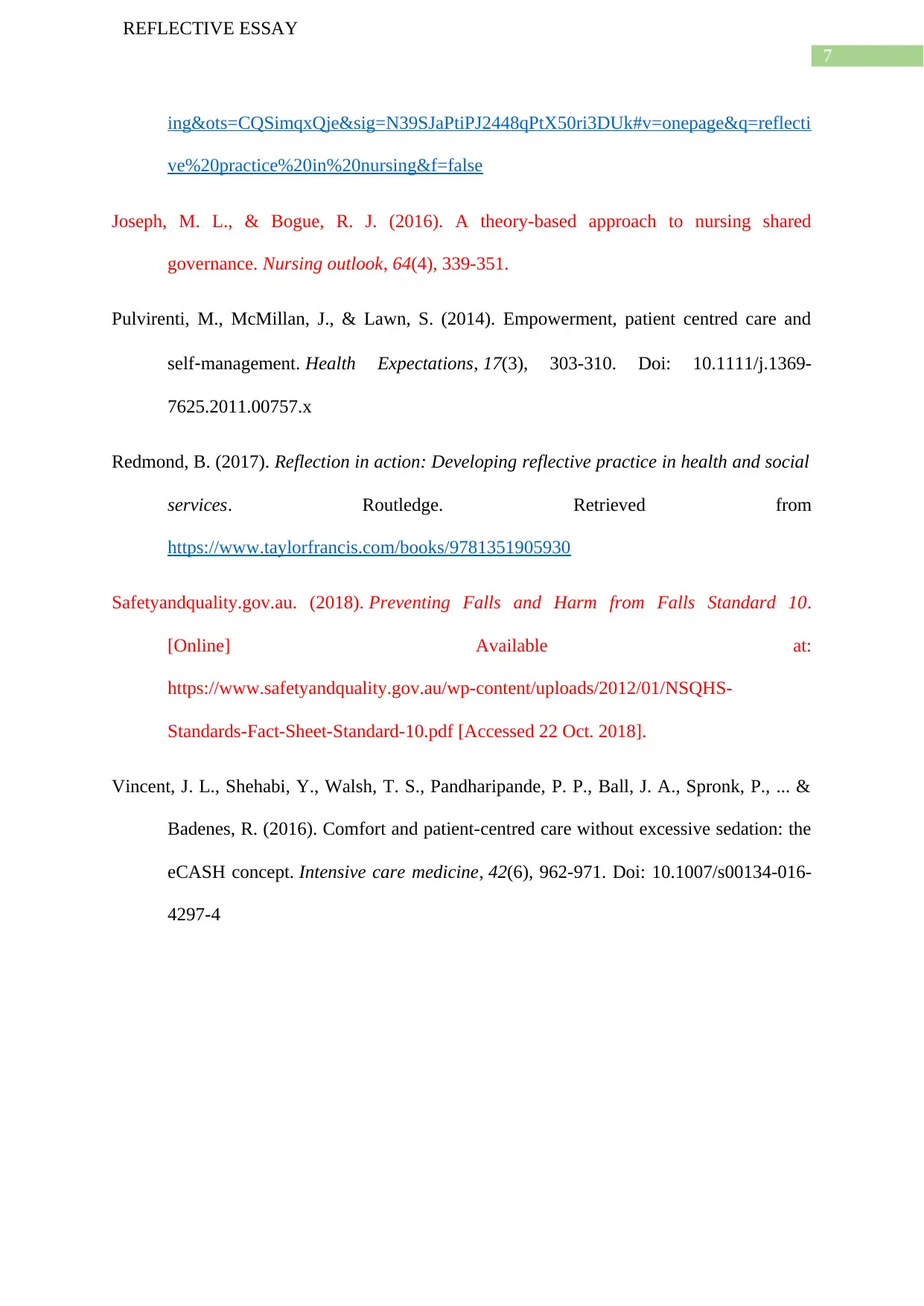
7
REFLECTIVE ESSAY
ing&ots=CQSimqxQje&sig=N39SJaPtiPJ2448qPtX50ri3DUk#v=onepage&q=reflecti
ve%20practice%20in%20nursing&f=false
Joseph, M. L., & Bogue, R. J. (2016). A theory-based approach to nursing shared
governance. Nursing outlook, 64(4), 339-351.
Pulvirenti, M., McMillan, J., & Lawn, S. (2014). Empowerment, patient centred care and
self‐management. Health Expectations, 17(3), 303-310. Doi: 10.1111/j.1369-
7625.2011.00757.x
Redmond, B. (2017). Reflection in action: Developing reflective practice in health and social
services. Routledge. Retrieved from
https://www.taylorfrancis.com/books/9781351905930
Safetyandquality.gov.au. (2018). Preventing Falls and Harm from Falls Standard 10.
[Online] Available at:
https://www.safetyandquality.gov.au/wp-content/uploads/2012/01/NSQHS-
Standards-Fact-Sheet-Standard-10.pdf [Accessed 22 Oct. 2018].
Vincent, J. L., Shehabi, Y., Walsh, T. S., Pandharipande, P. P., Ball, J. A., Spronk, P., ... &
Badenes, R. (2016). Comfort and patient-centred care without excessive sedation: the
eCASH concept. Intensive care medicine, 42(6), 962-971. Doi: 10.1007/s00134-016-
4297-4
REFLECTIVE ESSAY
ing&ots=CQSimqxQje&sig=N39SJaPtiPJ2448qPtX50ri3DUk#v=onepage&q=reflecti
ve%20practice%20in%20nursing&f=false
Joseph, M. L., & Bogue, R. J. (2016). A theory-based approach to nursing shared
governance. Nursing outlook, 64(4), 339-351.
Pulvirenti, M., McMillan, J., & Lawn, S. (2014). Empowerment, patient centred care and
self‐management. Health Expectations, 17(3), 303-310. Doi: 10.1111/j.1369-
7625.2011.00757.x
Redmond, B. (2017). Reflection in action: Developing reflective practice in health and social
services. Routledge. Retrieved from
https://www.taylorfrancis.com/books/9781351905930
Safetyandquality.gov.au. (2018). Preventing Falls and Harm from Falls Standard 10.
[Online] Available at:
https://www.safetyandquality.gov.au/wp-content/uploads/2012/01/NSQHS-
Standards-Fact-Sheet-Standard-10.pdf [Accessed 22 Oct. 2018].
Vincent, J. L., Shehabi, Y., Walsh, T. S., Pandharipande, P. P., Ball, J. A., Spronk, P., ... &
Badenes, R. (2016). Comfort and patient-centred care without excessive sedation: the
eCASH concept. Intensive care medicine, 42(6), 962-971. Doi: 10.1007/s00134-016-
4297-4
1 out of 8
Related Documents
Your All-in-One AI-Powered Toolkit for Academic Success.
+13062052269
info@desklib.com
Available 24*7 on WhatsApp / Email
![[object Object]](/_next/static/media/star-bottom.7253800d.svg)
Unlock your academic potential
Copyright © 2020–2026 A2Z Services. All Rights Reserved. Developed and managed by ZUCOL.




